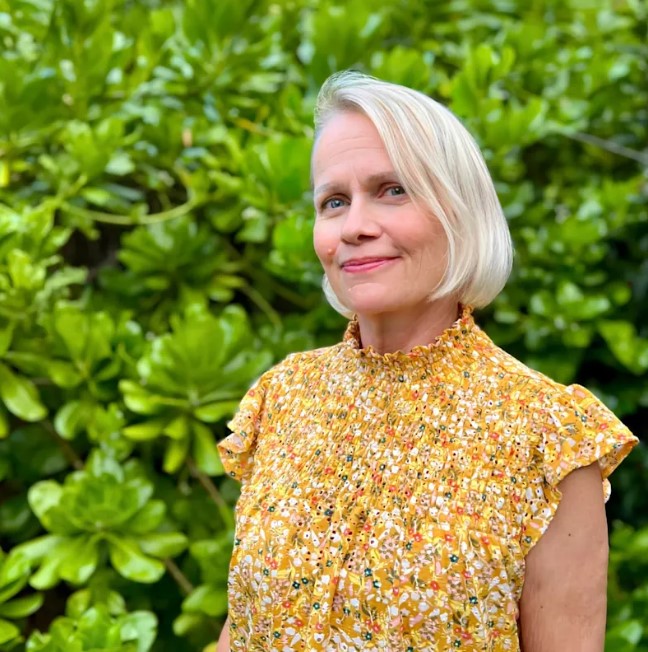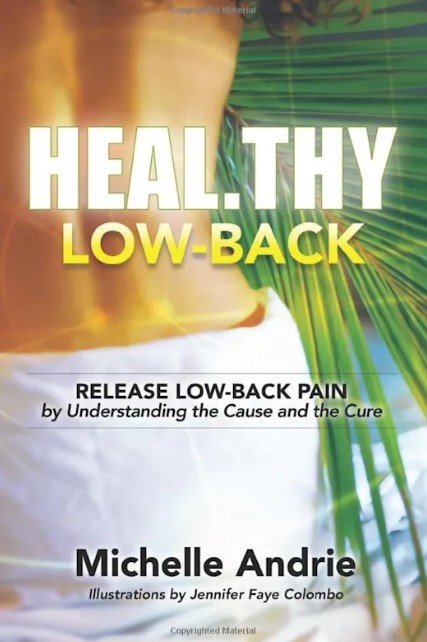Michelle Andrie is an acclaimed 30- year Yoga Therapist and the creator of the Heal.thy Low-Back Program. She has transformed her successful program for alleviating low-back pain into aninteractive and easily accessible book titled “Heal.Thy Low Back.”
Drawing from her own personal experience of overcoming low-back pain and her extensive work in guiding countless individuals towards freedom from their own back issues, Michelle has created a truly exceptional publication. Her belief in empowering each person to independently interpret and resolve their distinct and varied low-back challenges is at the heart of this innovative book, which embraces a holistic approach to healing.
Within the pages of “Heal.Thy Low Back,” readers will discover a wealth of valuable information. Michelle provides clear guidance on specific techniques for myofascial release, targeted stretching routines, and effective strengthening exercises. Furthermore, she takes readers on a comprehensive journey, helping them gain insight into the root causes of their low-back pain and assisting them in developing a daily practice to address these underlying issues.
This unique workbook serves as an indispensable resource for individuals seeking relief from low-back pain. Michelle’s expertise and compassionate approach shine through as she empowers readers to become active participants in their healing process. By incorporating her proven methods and a deep understanding of the body-mind connection, she equips readers with the tools they need to take control of their own well-being.
“Heal.Thy Low Back” stands as a testament to Michelle Andrie’s dedication to improving the lives of others through her exceptional yoga therapy techniques. Whether you are a beginner or an experienced practitioner, this transformative book has the power to unlock the secrets of a pain-free low back and pave the way to a healthier, more vibrant life!

Michelle answered our Q and A to share more invaluable information with our Women Daily Magazine readers!
Q: Can you explain the prevalence of low back pain in women and the factors that contribute to it?
A: Low back pain has been called the stress alarm bell by Dr. John Sarno from the New York School of Medicine. Many more women are stressed today by the high cost of living, gun violence, women’s rights being threatened, and the unstable political world. The alarm bell is sounding very loudly and I’m noticing in my Heal,thy low-back pain release program more and more women are asking for help to relieve their low back pain. Add to that the common causes of low back pain in women which are body structural issues, hormonal changes, birth trauma, sexual trauma, and weak core muscles. Women are in a world of hurt.
Q: What are some common causes of low back pain in women, and how do they differ from those in men?
A: Let’s take a look at the statistics — The National Institute of Health has found that 53.3% of women have Low Back Pain compared to 30.6% of men. The reasons more women have low back pain are: SI (Sacroiliac) joint problems that occur more often in women because they have a smaller SI joint surface area compared to men, which allows the SI joint to more easily misalign and even dislocate.
Also, when giving birth a hormone called relaxin is produced to relax the ligaments in the pelvis and soften and widen the cervix. Once the baby is born the pelvis is meant to go back into place but often the SI joint stays misaligned or dislocated causing chronic low back pain. SI joint problems are often overlooked and there is no real remedy offered by traditional medicine. A chiropractor can put the SI joint back in but it will pop back out again because the ligaments that hold the SI joint into place are overstretched. The only real solution is to learn to put the SI joint back into place and strengthen the abdominal muscles to keep the SI joint in alignment.
Not one health practitioner I met along the way in my journey out of low back pain taught me how to put my SI joint back in place. I figured out how to do it myself and now, I teach women how to put their SI joints back in place and strengthen the muscles that can hold it in place. PMS or Premenstrual syndrome is a hormonal condition many women get before their periods. PMS can cause low back pain because of the swelling that occurs in the pelvic bowl, low back, and abdomen. The pain will subside when menstruation ends and can be treated with anti-inflammatories as well as heat to relax the whole pelvic area. Myofascial release ball work in the low back, piriformis and butt cheeks, and iliopsoas muscles, along with specific stretches to open the low back, butt cheeks, and pelvis also help to release PMS pain. Endometriosis is a painful disorder in which tissue that normally lines the inside of the uterus — the endometrium — grows outside the uterus.
Symptoms include:
- Painful menstruation
- Severe abdominal pain
- Lower back pain
Endometriosis can be treated with anti-inflammatories as well as heat to relax the pelvis and low back and myofascial release ball work along with specific stretches. Piriformis Syndrome occurs when the piriformis muscle, which is the large muscle located below the glutes in the buttocks, spasms.
Hormonal changes can be a factor. We squeeze our butts when we want control. Once the butt cheeks grab the piriformis grabs and it can compress the sciatic nerve which sends radiating pain down the back of the leg. Myofascial release ball work in the butt cheeks and piriformis stretches really help to relieve the pain of piriformis syndrome. Letting go of control and accepting everything as it is can go a long way in relieving sciatica and piriformis syndrome. Tailbone pain is usually the result of injury or chronic irritation. It is more common in women due to the differences in the shape and angle of the pelvis or from injury during childbirth. Pain is felt while sitting, or moving from standing to a seated position.
The pain can be relieved when standing along with myofascial release ball work and stretching which can help release scar tissue and reposition the tailbone. Osteoarthritis is found in the facet joints.
Age and weight are factors. Arthritis can break down the fibrous cartilage in the facet joints causing the bones to rub together, producing pain in the upper or lower back, groin, buttocks, and thighs.
The pain and stiffness are worse in the morning. Osteoarthritis can also lead to Spinal Stenosis a condition where the nerve channel in the spinal column gets narrower, putting pressure on the spinal cord and nerve roots. The primary symptom of this condition is numbness in the legs and pain while standing or walking. To ease the discomfort, one can do myofascial release ball work, stretching the muscles in the lower back, strengthening the abdominal muscles, and correcting body posture to take pressure off the low back.
I have worked with many women with spinal stenosis who are back walking, standing and sitting comfortably. Degenerative Disk Disease occurs when a vertebra slips over the one below it due to degeneration. The condition is more common in post-menopausal women due to low estrogen levels which degrade the spinal discs and loosen the ligaments that hold the vertebrae together causing spinal instability. This results in lower back pain radiating into the legs and pain when walking due to spinal cord compression.
Myofascial release ball work, low back muscle stretching, abdominal strengthening, and correcting body posture to take pressure off the low back and reduce the pain and stop the progression of the disease. Swayback, also known as Lordosis, occurs when the iliopsoas muscles in the front of the body contract, pushing the sacrum up into the lumbar spine. This can result in disk problems such as degenerative disk disease, slipped disks, bulging disks, and herniated disks in the lower back. The iliopsoas muscles, which are part of the body’s fear system, contract to protect our soft underbelly. If we experience chronic fear and anxiety, these muscles can remain tense. To alleviate this issue, one can engage in myofascial release ball work, stretch the iliopsoas and low back muscles, and strengthen the abdominal muscles.

Additionally, practicing meditation, breathwork, and mindset strategies can help reduce fear and anxiety
Q: Are there any specific lifestyle factors or habits that increase the risk of low back pain in women?
A: Lifting or carrying heavy objects can strain the SI ligament, which is responsible for holding the joint in place. Due to the joint’s shallowness, it can easily pop out when under pressure.
Additionally, lifting and carrying can put extra pressure on the lower back. Women, who are often the primary caretakers of children, may have to lift and carry babies, toddlers, children, and all of their belongings. Poor posture is a significant contributor to the development and worsening of low back pain. The most common postural problems that lead to low back pain include having flat feet, which means that the gracilis muscle in the upper inner leg is not functioning properly. This muscle is responsible for pelvic stabilization, and when the pelvis becomes unstable, it can no longer support the sacrum or lumbar vertebrae.
If the feet are ducking outward, it may indicate a tight piriformis muscle that can push against the sacrum, causing it to jam up into the lumbar vertebrae and compress the low back. Swayback or lordosis exacerbates this compression even further, while rounded shoulders and a forward head posture place additional strain and stress on the low back.
Creating better posture is the ultimate goal in my Heal.thy Low-Back book and program. If your abdominal muscles are weak, your low back can end up compensating for the lack of support. This is often caused by pregnancy and can lead to muscle contractions and compression in the vertebrae of the lower back. Strengthening your abdominal muscles can help alleviate this issue and restore proper support for your core. Unhealthy eating habits can lead to an increase in body weight, which can further strain the lower back. Disassociation from the body by giving the mind more power than feelings and intuition. Not listening to the body and giving it rest, healing movements, and proper nutrition. This is a cultural problem.
Q: How do pregnancy and childbirth affect a woman’s risk of developing low back pain?
A: When a woman is pregnant, the baby’s weight and abdominal muscle stretching can weaken her core strength. This can cause the low back to work harder, leading to compression, strain, and stress. Additionally, the hormone relaxin that kicks in to relax the ligaments in the pelvis and softens and widens the cervix can cause the sacrum to misalign or dislocate setting up the mother for chronic low back challenges. Childbirth can be a painful experience for mothers. Back labor is one such painful condition that can occur. Additionally, birth trauma like the baby jamming into the sacrum or tailbone, lead to pain during labor and set the mother up for low back challenges in the future.
Scar tissue growth due to C-sections can also pull- on muscles in the front of the body such as the iliopsoas, and psoas, as well as muscles in the back like the quadratus lumborum and the erector spinae, potentially causing future low back issues.
Q: Are there any hormonal factors that play a role in women’s susceptibility to low back pain?
Yes, Many!! PMS, endometriosis, relaxin in pregnancy and low estrogen levels which degrade the spinal discs and loosen the ligaments that hold vertebrae together causing spinal instability.
Q: What are some effective strategies or exercises that women can do to prevent or manage low back pain?
A: The most effective strategy is to create a daily practice that incorporates myofascial release ball work, stretching the iliopsoas and low back muscles, and strengthening the core muscles. Also, learning to put the SI joint back in place and creating better posture. For added relaxation and stress reduction, incorporate meditation and breathwork into the daily routine.
Q: Are there any differences in the treatment options for low back pain between men and women?
A: When the causes are hormonal or SI joint misalignment (because more women than men have SI joint problems).
Q: Can you discuss the impact of menopause on low back pain in women and any specific considerations for managing it?
A: Osteoporosis is brittle or fragile bones due to hormonal changes that often cause hairline fractures in the lumbar spine vertebra. Also, low estrogen levels degrade the spinal discs and loosen the ligaments that hold vertebrae together causing spinal instability. What role does posture and body mechanics play in preventing and alleviating low back pain in women? Everything I teach on how to relieve low back pain no matter the cause, focuses on creating a Pain-Free Low Back Posture.
This is an excerpt from my book: PAIN-FREE LOW-BACK POSTURE STANDING – ●
Stand with your feet inner-hip width apart. I place my hands at the inside of my hip bones, point my fingertips down and look down, lining up my feet with my hips, knees, and ankles. ● Make sure your feet are lined up and facing straight ahead. No ducking out or pigeon-toeing in. ● Press into the outer edges of your heels as you lift and spread your toes. ● Create a soft bend to your knees. ● Slightly roll your inner legs in. ● Pat out your butt cheeks to make sure they are loose and free. ● Drop your tail and sacrum down as if just beginning to sit in a chair. ● Lift your hip bones up. ● Draw your ribs in and down which begins to work your abdominals. ● Roll your inner arms out. ● Squeeze your shoulder blades together and take them down toward your tail. ● Allow your head and neck to be loose and free.
As you try this, notice how the new Pain-Free Low-Back Posture feels. It will feel awkward at first because we are changing the way you’ve stood since childhood. Are there any particular challenges that women face in seeking treatment for low back pain, and how can they overcome them? SI joint dysfunction is often misdiagnosed in women and when it is there is no remedy offered by traditional medicine that works to alleviate the pain. It’s unfortunate that traditional medicine doesn’t teach women how to realign their SI joint, but I’m spreading the word on how to do it yourself and strengthen your abdominal muscles without using your low back so the abdominal muscles can help hold the SI joint in place.
Overall, there needs to be a much greater emphasis on woman’s health to find better treatment options for women. More awareness is how to overcome this problem. Women must learn to take care of themselves first every day before going out to help others. A whole-body daily practice to create better posture physically and mentally will heal the low back and release low back pain.

To learn more about Michelle Andrie, her book and low back pain program visit:
https://www.agelessmovemore.com/
Purchase the book on Amazon: shorturl.at/iGJO9
Follow Michelle on Facebook: Ageless Movement Practices Membership Group | Facebook
